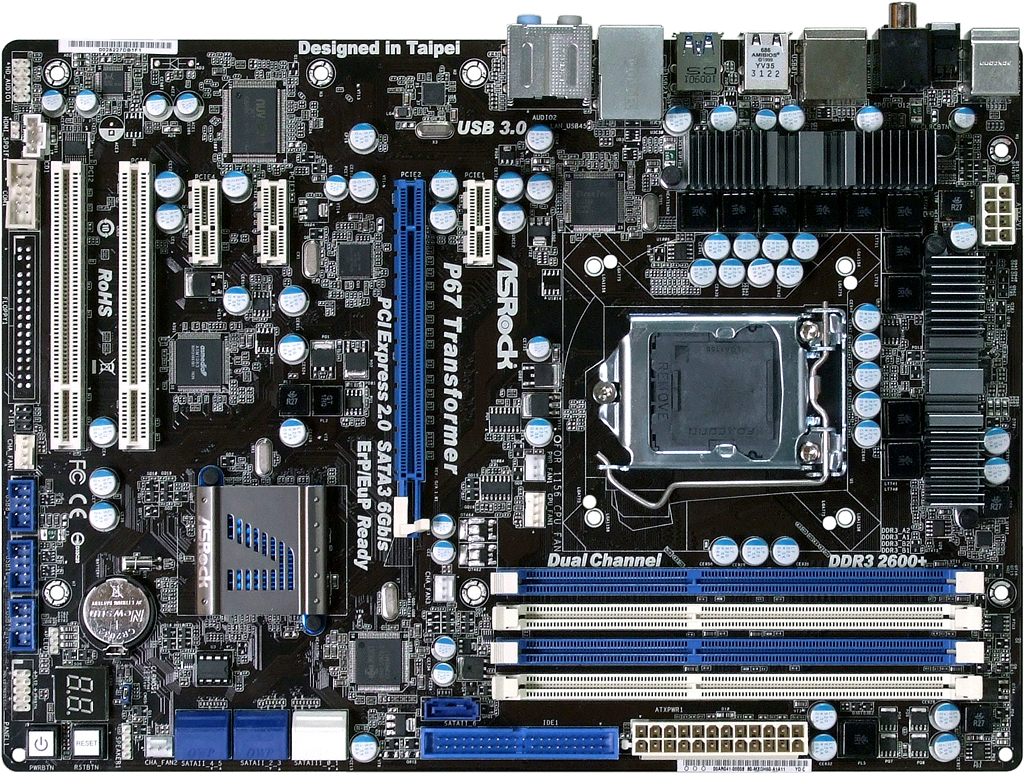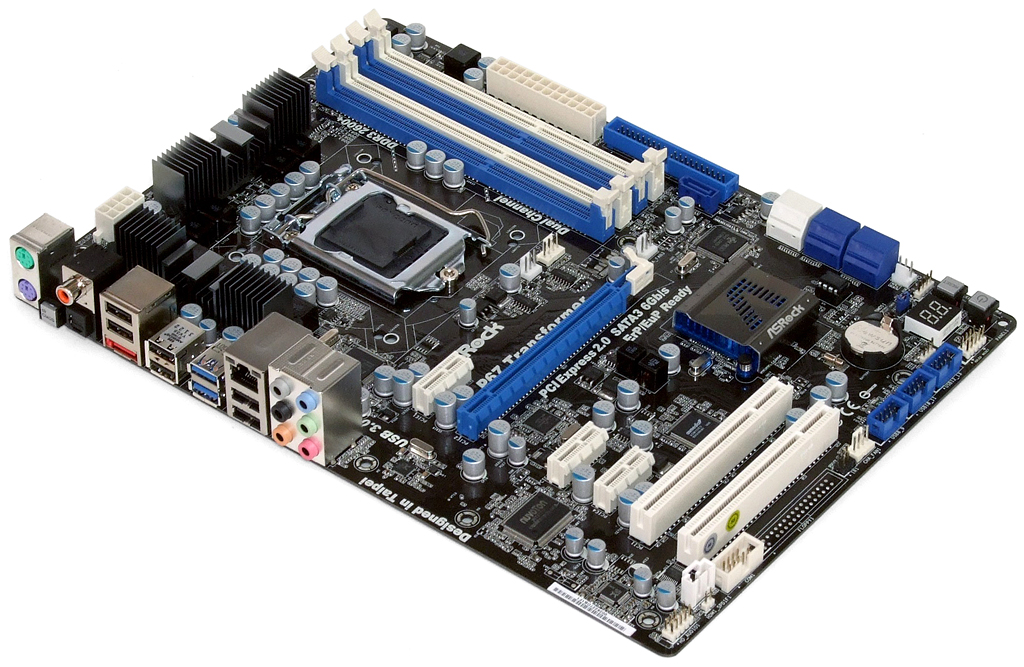ASRock P67 Transformer: P67 Gets LGA 1156 Compatibility
Upgrading to Intel’s P67 will certainly require a new motherboard, but the fact that you won’t need a new CPU appears to be Intel’s dirty-little-secret. ASRock found the secret and exploited it, bringing next-generation performance to today’s processors.
LGA 1156 On P67? Meet The P67 Transformer
In an effort to produce the most cost-efficient, space-efficient, and energy-efficient design possible, Intel decided to do away with the clock generator normally found as a separate motherboard IC and instead integrate it into the chipset. This has created a conundrum for low-cost overclocking enthusiasts because the P67’s clock generator cannot “unlock” the ratios for other devices, such as its USB 2.0 and SATA 6Gb/s controllers. As a result, adjusting the BCLK overclocks a number of other subsystems that simply don't like to be overclocked. For more on overclocking Sandy Bridge, check out Intel’s Second-Gen Core CPUs: The Sandy Bridge Review.
Anyone interested in a Sandy Bridge-based CPU is now forced to pay a premium on unlocked Extreme Edition or K-series CPUs in order to achieve anything more than the slightest clock increase. But other than the piggybacked CPU clock signal, the P67’s DMI interface is unchanged from that of its P55 predecessor.
ASRock considered the fact that the same signal was being used and went to work adding a P67 PCH to a typical P55 motherboard component set. For fans of the ASRock brand, the end result looks strikingly familiar.
When it comes to combining different generations of hardware, ASRock is usually first to show up and last to leave. The same company that beat its competitors to the punch with USB 3.0 front-panel support has finally abandoned Windows XP users by omitting the floppy header (which eases the installation of AHCI drivers with the OS). And yet keeps its legacy Ultra ATA header. I’m sure we have an LS-120 drive for that somewhere…
Most painfully missing from the P67 Transformer is support for any secondary PCIe x16 graphics card in SLI or CrossFire mode. In place of that long slot is ASMedia’s ASM1083 PCIe to legacy PCI connector because--get this--Intel finally dropped PCI support from P67 Express. These features combine with a set of mounting holes for third-party LGA 775 coolers to make upgrades easy for owners of older systems, so long as they don’t expect their legacy OS to include AHCI or RAID drivers. For Windows XP die-hards, slipstreaming the P67’s controller drivers onto a copy of the installation CD is still an option.
Get Tom's Hardware's best news and in-depth reviews, straight to your inbox.
Current page: LGA 1156 On P67? Meet The P67 Transformer
Prev Page Bringing LGA 1156 Up To Speed Next Page The “Friendly Competition”-
James296 Hmmm, I'll be keeping an eye on ASRock for future products that I may buy. especially for my next buildReply -
kcorp2003 My next build is in Q1 or Q2 2012. where ivy bridge cpu is eight-core processors for mainstream and quad-core processors at the entry level segment. As of right now i'm sticking to my Q9550 3.4Ghz and HD4870. I can live with the extra few seconds or mins for boot up, loading, compressing, unzip, converting, installing, etc... can waste the time reading some toms articles :) or other important things like eating.Reply
Also most game engines aren't optimize yet to take advantage what I have. except for Dx11. I know frostbite engine 2.0 thats making Battlefield 3 will be optimize for multi core and Dx11.
All of my games plays well on 1680x1050 on medium settings. So I'm good. Don't need anything yet. Unless I want to game in 3D. then ill need to invest for a new complete build to play 3D comfortably; GPU (crossfire or SLI), 120Hz monitor, new CPU @ 4Ghz, Window 7, SSD (hopefully), x78 mobo, RAM, and wrap it up with a nice case with lots of air flow and wiring management. which i'm saving up money for in 2012 before the world ends :) -
joytech22 xxsk8er101xxMixing technology never works.Reply
You mean like DVD/BD Combo drives? they work pretty damn well in my opinion.
Asrock has done pretty well for themselves, I'm going to keep a close eye on them as long as they provide, at the very least, AMD Bulldozer boards that support SLI.
-
PreferLinux xxsk8er101xxI dunno why you would buy this. Mixing technology never works.joytech22You mean like DVD/BD Combo drives? they work pretty damn well in my opinion.Asrock has done pretty well for themselves, I'm going to keep a close eye on them as long as they provide, at the very least, AMD Bulldozer boards that support SLI.You mean, like DVD drives, that support CDs as well???Reply -
dco Sandy bridges sacrifices far out-way its slight performance increase, quite disappointing. I wont be upgrading until both performance and scalability are met.Reply -
joytech22 PreferLinuxYou mean, like DVD drives, that support CDs as well???Reply
Or DVD/CD/BD/BDXL/Litescribe as well????? :D -
nekromobo anyone asked or answered if there's any real need for these i5-750 or k2500/k2600 if you have lga775 3.2-3.6ghz core2quad.Reply
500-1k update for few measly fps, no thanks.
I know power is some concern but the new mobo+cpu will eat power too no matter how you look at it. -
apache_lives Who would want to use a crappy 2 year old motherboard with a new processor and video card and everything? who cares - new rig = NEW STUFFReply
dcoSandy bridges sacrifices far out-way its slight performance increase, quite disappointing. I wont be upgrading until both performance and scalability are met.
the "new" i5's and i7's arent revolutionary, there evolutionary - those of you with older i5's and i7's wont see much of a jump thats expected, there just newer models etc - why are you complaining?
xxsk8er101xxI dunno why you would buy this. Mixing technology never works.
agreed, even if it did, why bother?
James296Hmmm, I'll be keeping an eye on ASRock for future products that I may buy. especially for my next build
asrock and MSI - i dont understand why people concider there products, MSI in perticular - there horrid rubbish, MSI should stand for "might start intermittently" and asrock at work we call assrock or ascock - bla.
Modding and unofficial support and all that isnt new, asus used to always beat everyone in those reguards, if you think about it, the socket 478 and 775 days - all those used the same GTL/FSB design, technically you can use the original 845 chipset with a Q9650 (aswell as the Intel Atom, Pentium M, Intel Core Duo, Xeon and so on) provided you have the right pin-out and vrm design (and bios obviously) and give it AGP, SDR ram, IDE etc but again WHY BOTHER?


